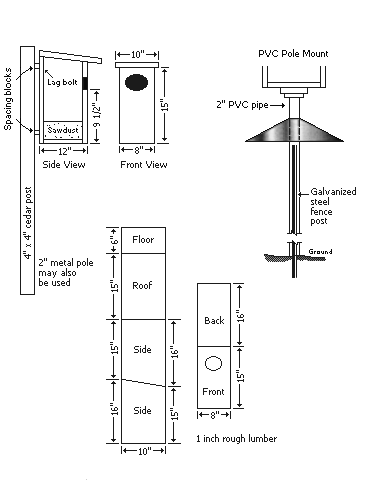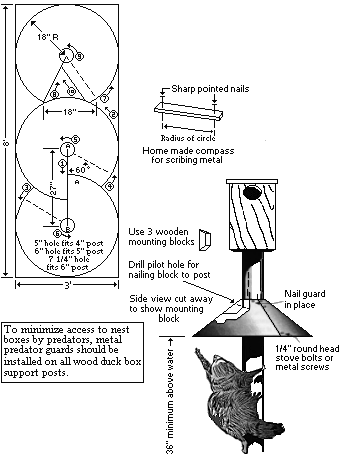

|

|
Wood Duck - Nest Boxes
Wood Duck
(Aix sponsa)
Nest Boxes
Nest Box Design
Nest boxes should be constructed of a weather-resistant wood; cedar or
cypress is often recommended. The wood can be painted, stained, or treated, but
only on the outside surface. The entrance hole should have a 4-inch diameter or
be an oval that is 3 inches high and 4 inches wide. Numerous nest box designs
have been used with success; fig. 1 provides one
example. A 3-inch wide strip of 1/4-inch mesh hardware cloth should be securely
fastened to the inside of the box under the entrance to function as a ladder for
the hen and newly hatched ducklings. The cut edges of this cloth should be
folded back before insertion to avoid injury to the ducklings. Another method of
assisting the ducklings in their climb from the nest to the entrance hole is to
roughen up the wood surface under the hole with a chisel. A 3-inch layer of
coarse sawdust should be placed at the bottom of the box to serve as nesting
material and to help prevent the eggs from rolling around. The lid or one side
of the box should be removable to facilitate monitoring and cleaning. All wood
duck boxes should be fitted with a galvanized sheet metal predator guard (see fig. 2). The predator guard should be placed 6 to 12
inches below the bottom of the box.
Figure 1
Wood duck nesting box design

Nest Box Installation
Wood ducks are highly secretive in selecting nest sites to minimize impacts
of nest predators and competition from other wood ducks. Therefore, it is
important to locate individual nest boxes in relatively secluded areas within
timber stands where natural cavities would occur naturally. Nest boxes can be
placed either on land or over the water. If located over the water, they should
be placed at least 4 feet above the high water level and the entrance hole
should face the open water rather than the shoreline. Because of ease of access
by predators, installation of nest boxes directly on trees should be avoided.
Nest boxes placed on land should be located from 30 to 150 feet away from the
shoreline. Boxes placed directly on the shoreline appear to be more likely
frequented by nest predators. Since the hen must lead her ducklings to water
soon after they hatch, the area between the nest box and the water's edge should
be free of any major obstacles such as roads or fencing. Nest boxes placed on
poles over water are generally more easy to monitor than those placed in trees.
Regardless of whether the box is placed over the water or land, the entrance
should be clear of obstructions to provide easy access for the ducks.
In order to maximize nest box use while minimizing nest
dumping, it is generally recommended that nest boxes should be placed at
least 600 feet apart and should not be visible to one another. When placing nest
boxes in isolated locations, consider ease of access for monitoring purposes.
Figure 2
Standard cone-shaped predator guard
Below is a layout for cutting three predator guards from a 3 ft x 8
ft sheet of 26-gauge galvanized metal. When installing the guard, overlap the
cut edge to the dotted line. To facilitate cutting, follow the sequence of
numbers. Make circular cuts in counterclockwise direction. To make initial cut
on line A-B, make a slot at A with a wood chisel, use tinsnips, and wear leather
gloves.

Nest Box Monitoring
Before nesting boxes are erected, a maintenance and monitoring plan to ensure
the success of the program should be developed. Old nests and those of invasive
species such as European starlings must be cleaned out regularly if the boxes
are to be used more than once during a nesting season. The monitoring program
should ensure that boxes are monitored at least once before the beginning of the
nesting season, and should be checked at least once a month during the nesting
season if multiple use of nest boxes per nesting season is desired. Boxes should
remain out during the winter to provide winter cover sites for screech owls and
other resident birds. For Wildlife Habitat Council member organizations, the
monitoring program may enroll in WHC's Nest Monitoring Program, useful in WHC's
Corporate Wildlife Habitat Certification Program. Enrollment can be accomplished
by contacting the WHC Nest Monitoring Program Coordinator at (301) 588-8994.
|
 Heartwood Wood Duck Joy Box Birdhouse
Heartwood Wood Duck Joy Box Birdhouse
John James Audubon did some of his most famous bird drawings as he explored on foot along the Natchez Trace, which happens to be located near Star, Mississippi, where we design and make all our Heartwood homes. While birding has come a long way since Audubon's time, today with our four-season nesting boxes and basic homes, you don't need to go to anywhere to enjoy all manner of wonderful bird life flocking to your door. Discreet complements to any landscape, these hardy havens are convenient, long lasting and beautiful-the picture perfect start to your life in birding!
Season after season, this delightful nesting box is a joy to behold and a breeze to maintain thanks to easy twist latch and slide-front panel that also inverts for winter roosting. So easy to use, so easy to love, it turns birding into child's play! Rugged construction features 13/16" solid cypress and headed ring shank stainless steel nails.
Dimensions: 11" x 12" x 24 1/2"; 4" hole

|
 Coveside Bufflehead Duck House
Coveside Bufflehead Duck House
The Bufflehead, with its striking white sides and
white patch on its head, is smaller than most cavity nesting
ducks.Dependent on nest boxes, this house is ideal due to the scarcity of holes
excavated by a large woodpecker or flicker.
RANGE: Breeds in Alaska east to
western Quebec, and south in mountains to Washington and Montana. Winters in
southern U.S., south to Mexico, Gulf Coast and northern Florida.
HABITAT:
Nests on wooded lakes and ponds; winters mainly on salt bays and
estuaries.
(17-3/4"h x 9-1/4"w x 11"d)
|
 Coveside Common Merganser Duck House
Coveside Common Merganser Duck House
This
house provides a perfect nest box for mergansers that normally nest in tree
cavities. Positioning a house on a pole in the open water
provides extra protection from predators.
RANGE: Breeds
across Canada from eastern Alaska, Manitoba and Newfoundland south in mountains
to California, northern New Mexico, Great Lakes and northern New England.
Winters south to northern Mexico and Georgia; also in
Eurasia.
HABITAT: Breeds on wooded rivers and ponds; winters
mainly on lakes and rivers, occasionally on salt water.
(24-1/4"h x 11"w x 13"d)
|
 Coveside Small Wood Duck House
Coveside Small Wood Duck House
"Dump
nesting" occurs when a number of females lay eggs in a single house, which
sometimes results in clutches with over 70 eggs.
Mississippi State University did a study of Wood Ducks in
an effort to reduce this problem. A smaller nest box was designed and "dump
nesting" was reduced. Although fewer ducklings are fledged from each box, the
survival rate is improved and the cost per fledgling is less. This box comes
with a wire ladder and nesting chips, and the front opens for observation and
cleaning.
RANGE: Breeds from British Columbia south to
California, and from Montana east to Nova Scotia, and south to Texas and
Florida; absent from Rocky Mountains and Great Plains. Winters near Pacific
Coast north to Washington, and to New Jersey in East, rarely further
north.
HABITAT: Nests beside wooded rivers and ponds. Visits
freshwater marshes in late summer and fall.
(17"h
x 7-1/2"w x 15"d)
|
 Coveside Wood Hooded Merganser Duck House
Coveside Wood Hooded Merganser Duck House
Coveside's Wood Duck House opens two ways for
observation and cleaning, and has an internal ladder for the duckings to climb
out. Mother calls ducklings to the protection of the open
water at age one day.
RANGE: Breeds from British Columbia
south to California, and from Montana east to Nova Scotia, and south to Texas
and Florida; absent from Rocky Mountains and Great Plains. Winters near Pacific
Coast north to Washington, and to New Jersey in East, rarely further north.
HABITAT: Nests beside wooded rivers and ponds. Visits
freshwater marshes in late summer and fall.
(24-1/4"h x 11"w x 15"d)
|
Ads by Google
|

|
Woodside Gardens
The Registry of Nature Habitats  Copyright
Copyright  1999 -
All Rights Reserved 1999 -
All Rights Reserved
Last Updated:
| |
|





 Heartwood Wood Duck Joy Box Birdhouse
Heartwood Wood Duck Joy Box Birdhouse

 Coveside Bufflehead Duck House
Coveside Bufflehead Duck House
 Coveside Common Merganser Duck House
Coveside Common Merganser Duck House
 Coveside Small Wood Duck House
Coveside Small Wood Duck House
 Coveside Wood Hooded Merganser Duck House
Coveside Wood Hooded Merganser Duck House


 1999 -
All Rights Reserved
1999 -
All Rights Reserved
